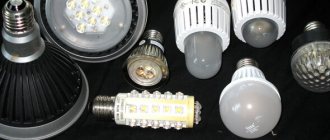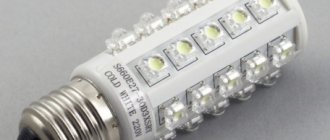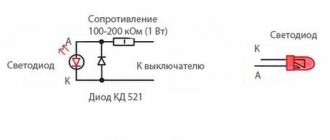Why are the lights flashing?
The reason is simple. An LED or fluorescent light bulb blinks when the light is turned off due to the presence of the backlight LED power circuit and the design features of these lamps. ... They are small, but they are enough for the capacitor in the lamp to accumulate a charge sufficient to start the lamp (which is installed in the lamp base).
Interesting materials:
In what format should I save videos for Instagram in Adobe Premiere Pro? In what geographical region of the world did the ancient Greek civilization develop? Which country doesn't have snakes? In which state was the pension first introduced? In what climate zone and type of climate is Vladivostok located? Which climate zone has low rainfall? In what climate zone is the city of Perm located? In what climate zone is Irkutsk located? In what climate zone is Ukraine located? What month is the summer session?
The LED lamp began to shine dimly due to low voltage
The first thing you should check when looking for an answer to why an LED lamp is dim is whether the voltage level in the network is sufficient. The lighting device is powered by an alternating current network, so when the voltage drops, even a high-quality lamp with good working light does not shine at full strength.
This is easy to check - just connect another device to the AC mains. If this LED lamp also begins to shine dimly, then the reason is low voltage. This problem is typical for suburban housing. This can be solved by installing a stabilizer on the light and socket.
Read also: Cold sweat, causes and treatment
Using the glow for good
Let me make a reservation right away: only “smoldering” lamps will do; it’s unlikely that it will work with blinking ones. I personally witnessed the long operation of lamps in this mode, but I do not rule out that these experiments can significantly shorten the life of the lamps. There are too many different lamp designs and not enough data to make clear conclusions.
So, a weak glow can be used as a feature, an additional lighting option. A night light in the corridor, a romantic twilight in the room - “smoldering” can be used effectively. The main thing is to learn how to properly control this glow.
Good results will be achieved by proper “correct” wiring and switches without backlights. That is, when the lamp is turned off, it does not glow at all.
The same capacitor, but connected in parallel with the switch, can make it glow. Also, capacitors of 0.047-0.1 µF for 400-600 volts are suitable. Here you may have to select a container for the desired glow. For convenience, you can use a two-key switch instead of a single-key switch: the first key must be connected according to the standard circuit, and the second through a selected capacitor. You will get two modes - normal and night light!
If the lamp glows initially, you can try connecting a capacitor in parallel with the lamp to eliminate it, and another capacitor, but of a larger capacity, to the second switch key. In general, you will have to experiment. But overall, I think this idea is quite interesting.
In all my experiments with the “night light” I used non-dimmable lamps. The photo below shows two types of cheap lamps that “smolder”.
Low quality LEDs
Contrary to popular belief, the quality of the light-emitting elements is unlikely to be the sole reason why an LED lamp glows on its own after being turned off. Theoretically, cheap LEDs of unknown origin may have low substrate insulation resistance, but this will more likely lead to leakage of current, initiating the glow. Such a defect should be revealed the first time the lamp is turned on during inspection during purchase, and any consumer will refrain from purchasing a lamp with reduced brightness or no glow.
Related video: The lamp shines but not brightly
Tips for choosing LED lamps
Organizing lighting with LED lamps is economically beneficial, but requires a certain approach to their selection.
The first thing to remember is that LED lamps cannot be cheap. Their design is very complex and requires certain production costs.
The second point is the instructions included with the light bulb. Study it carefully. Points that you should pay attention to in order to choose a high-quality light bulb that does not blink when turned off:
Attention! Some types of lamps have the ability to glow after being turned off. You will find information about this in the instructions for it.
More than half of the reasons for LEDs dimming when turned off is a backlit switch or poor quality of the light bulb.
To prevent combustion when switched off, when purchasing, you need to carefully read the instructions and choose a light bulb that suits the specific case.
Sometimes it is impossible to completely eliminate the weak burning of LED lamps when they are turned off. Their design is complex, and even trusted manufacturers can have similar problems (although less often than manufacturers of low-quality light bulbs).
Source
Features of LED lamp
The design of this type of lamp is more complex than its analogue with an incandescent filament. The principle of operation is based on the recombination of electrons and holes with transfer to another energy level, resulting in a glow that is a consequence of the release of photons.
These processes are facilitated by the use of certain LED semiconductor materials.
To understand why LED lamps light up when the lights are off, you need to look into its structure. The stores offer illuminators of different sizes and shapes. The internal structure is also different.
Probably everyone has noticed large differences in the price category of this product, from 100 rubles to a thousand. It is the features of the device that determine such a wide range.
To ensure acceptable lamp operating conditions, a current-limiting element is used. In simpler circuits, a resistor is used for this purpose.
Higher quality light sources operate on a different principle: the circuit is based on a diode bridge, which rectifies the mains voltage and supplies it to LEDs connected in series.
One of the main differences between modern lighting and conventional incandescent lighting is a constant supply of current; such circuits are called rectified.
The capacitor, which converts and stores energy, is located on the driver. Then the current is supplied through the circuit to the board, from it to the chips and diodes. A high quality LED lamp has a slightly different operating principle.
The basis is a diode bridge; it supplies energy to the LEDs in a series connection. Such sources will not be disturbed by a dim glow after the switch is turned off.
Do not confuse an LED lamp with a fluorescent lamp. It is luminescent light emitters that are called energy-saving. Most often, they can be distinguished by their spiral-shaped flasks. They gradually gain light when turned on, and there are no problems with the glow when the switch is off.
Effect of a burning light bulb after switching off
For those for whom a slight night glow does not cause discomfort, another question arises: is it safe? And how does this affect energy consumption? There is no danger in the smoldering light. The lamp will not burst in the middle of the night or crack. Burnout is possible, but it is an extremely rare case.
The main disadvantage of LED bulbs glowing when the switch is off is the rapid depletion of the illuminator. The fact is that the circuit is designed for a certain number of starts and burning times. Therefore, after two months of almost continuous glow, the light bulb becomes unusable.
Pay attention to the proportionality of the power and the radiator of the light emitter. If the radiator is small, but the light output is quite powerful, then you should not buy one. Preference should be given to aluminum radiators. If the issue is not fundamental, then it is better to take the switch without backlight.
Features of the power supply circuit
There are two schemes for connecting LED lamps:
In the second case, it is necessary to use a resistor that limits the current. You can find out the required power when purchasing it in a store.
The resistor has the ability to accumulate thermal energy, which is enough to dimly glow when the LED lamps are turned off.
If we are talking about T8 LED lamps (in the form of a tube), then connecting them to additional devices is not required - everything you need is in the lamp itself.
This is interesting! There are LED lights designed specifically to accommodate LED bulbs that will not dim when turned off.
If you want to replace an incandescent light bulb in a lamp with an LED one, then the voltage on its packaging should indicate 220 V. Next, we select according to the type of base (for example, E14 or E27 are the most common). In order not to make a mistake with the size of the base, you can take an old light bulb to the store.
Verification steps
Connection diagram
1. Check the presence of input voltage on the power supply, which should be equal to 220V.
2. The output of the power supply should be 12V, but not lower than 10V, because it is regulated by a resistor. ADJ output voltage regulator.
3. We measure the voltage at the input to the RGB controller or dimmer, it should be as in point No. 2.
4. We carry out a measurement on the contacts of the tape, it can be from 7V to 12V, since the controller controls the brightness of each color.
5. If a certain area connected by connectors does not light up or lights up dimly, check the voltage on it.
6. The RGB control unit or dimmer often comes with a remote control. A faulty remote control can turn off the lights or simply reduce the brightness to a minimum. The button may be stuck pressed, or contamination may have shorted the contacts on the board.
What should I do to make the lamp stop glowing or blinking when turned off?
Having done this, no current will flow to the charging capacitor, after which the lamp will no longer glow dimly or blink;
If you want to avoid this problem, then before purchasing a switch, pay attention to the presence or absence of backlighting. If it is not there, then the main problem will not appear; A good option would be to connect a regular lamp in parallel; using this option will prevent the energy-saving light source from burning when turned off.
This is achieved due to the fact that the current to recharge the capacitor will go to the filament (This method is not very good for just one reason. The purpose of purchasing LED lamps is to save energy and have a longer service life compared to incandescent and halogen lamps. When added to the circuit of a conventional lamp increases consumption, and accordingly all savings are lost. As a result, this solution is not ideal);
There are switches that have mandatory backlighting needed for some purpose. What to do in this case, and what actions to take?
A good solution to eliminate this problem would be to connect a resistor in parallel, which will help create additional resistance in the desired section of the electrical circuit. The main advantage of this method is its cheap price; you can purchase a resistor in absolutely any radio equipment store.
It is worth noting that the resistor will not negatively affect the normal operation of the LEDs. But when the switch is turned off, the backlight will work, and accordingly the resistor will consume current, which goes to charge the capacitor. Also don't forget to insulate the resistor, the best way to do this is to use heat shrink tubing.
You can connect it under the ceiling in a lampshade or in a lamp socket. For a more convenient connection of the resistor, a good option would be to use special Wago terminal blocks (in the image below).
The final step is to place the resistor in the box, after which you can enjoy the absence of blinking of the LED lamp after turning off.
Today, LED lamps have become the most popular light sources and there are many explanations for this: they are economical, fireproof, have the longest service life and also create the most comfortable lighting for vision. However, as with other alternative light sources, LEDs have their own problems. The most common is when the LED lamp glows after being turned off. We discussed the reasons for this phenomenon and ways to eliminate the glow in this article.
What to do and how to fix the problem
You can eliminate the causes of dim LED lighting yourself or, in some cases, by contacting an electrician.
The problem of poor wiring insulation can be solved by replacing it or re-insulating the damaged area. The location of poor-quality insulation is determined by special devices (homemade or purchased) in this way: within a minute, the maximum voltage is applied to the network and, with the help of special equipment, the location of the current leak is found. If you have no knowledge of electrical engineering, then it is better to trust a specialist.
Many manufacturers have begun to write on the packaging of LED lamps that their use is not recommended if there is a backlit switch. If there were no instructions on the packaging, you screwed the LED light bulb into the lamp, and it continues to glow faintly when turned off, you should try the following:
- replace the backlit switch with a regular one;
- remove the backlight (cut the wire that goes to the backlight bulb);
- Screw one incandescent lamp into the lamp, which will receive “extra” voltage. The value of this method is questionable, since it contradicts the idea of saving electricity;
- install an additional resistor with a resistance of 50 Ohms and a power of 2-4 W, which can be purchased at the store. Its connection is made parallel to the lamp in the ceiling lamp or in the socket, and the installation site is necessarily insulated with heat-shrinkable tubing. Thus, the voltage will not go to the LED light bulb, it will not light up after turning off, but the switch will remain illuminated.
LED lamps can burn when the switch is off due to the specificity of their design. Thus, the LED driver includes a capacitor capable of storing electricity. This design feature of LED light bulbs does not allow them to go out immediately after turning off, and they continue to glow faintly.
It is not recommended to purchase products from unknown manufacturers. They will not work correctly and will not last long and will burn after being turned off. In addition, a defective product can cause harm to the eyes due to flickering, white color temperature (instead of the declared warm light), etc.
If the electrical wiring is old, it must be replaced. In this situation, the best solution is to entrust the work to an electrician.
If the zero and phase are connected incorrectly, you need to reconnect: the phase to the switch, and the neutral wire to the light bulb.
The problem can be eliminated by purchasing a resistor made of special materials that prevent the accumulation of thermal energy.
Reasons for blinking when the lights are off
It often happens that after the light is turned off, the flickering of the lamp continues. This is not visible during the day, but at night faint flickering flashes become clearly visible. Why does the energy-saving lamp blink when the lights are off? This behavior of the device can occur for 3 reasons: a low-quality product, a bad backlit neon switch, or improper installation.
Malfunction and wiring problems
If the LED light flickers after turning off, the problem may be with the wiring. It is necessary to check how the phase cable is connected. The connection is considered correct when the phase passes through the switch and is not connected directly to the lamp. A diode indicator screwdriver will help you recognize the phase wire. Having distributed the wires correctly, the light bulb is once again checked for functionality. Blinking often occurs due to induced voltage. This is when the power wire is too close to the disconnected cable.
When working with wiring, you need:
- take into account its condition;
- follow safety precautions.
If the switch you are using does not have a night light, and the flickering continues, then it is better to completely replace the electrical wiring with a new one.
Watch this video on YouTube
Illuminated switch
Illuminated switches are the most popular among consumers. The design is equipped with a neon lamp or a simple LED, which makes it easy to find the switch at night. But with the addition of a new part, the LED light began to flicker. This is due to the small charge that accumulates on the filter capacitor:
- when the switch is turned on, electricity goes directly to the lamp, and when turned off, it goes to the LED;
- Due to the flow of current, the filter begins to constantly charge, and the lamp flickers.
Since there are 2 ways to stop the blinking of an LED lamp, choose one of them. Instead of an energy-saving model, install an incandescent lamp or disconnect the power circuit, turning off the backlight. If the lamp has 2 light bulbs, then by replacing one of them with an incandescent lamp, you can get rid of flickering. The fastest and easiest way is to install simple switches without backlighting.
Poor quality lamps
The light in the off state may blink when it is faulty. There are many products on the market that do not meet the standard requirements, and in an attempt to save money, many people buy devices from unknown manufacturers. If the product was purchased of poor quality, then it is enough to purchase a new lamp. Things to consider when purchasing:
- manufacturer;
- high-quality lamps are sold in whole packages;
- The product is checked for functionality.
Compact models are very popular. It is customary to install LED lamps with a cold temperature in utility rooms and corridors, and in children's rooms, living rooms and other living spaces - with a warm tint.
Turning off the backlight in the switch
To get rid of blinking in a 220 V lamp, you need to remove the LED or neon backlight from the switch. To do this, prepare all the necessary tools:
- flathead screwdriver;
- indicator screwdriver;
- wire cutters;
- knife.
Before starting work, turn off the electricity. If there are fuses installed in the house, they are unscrewed. If there is an automatic shut-off handle on the panel, then it is set to the “off” position. The work of disassembling the backlight is identical to replacing a simple switch:
- Decorative on/off keys located on the body have latches. They are pryed on both sides and carefully removed.
- To remove the device from the box, unscrew the mounting bolts.
- The contact wires must be de-energized. They are checked with an indicator screwdriver.
- Before disconnecting the wires, carefully remember their location.
- The body of the structure consists of 2 parts that are fastened with latches. Therefore, he is examined for their presence.
- Having found the latches, they are moved apart. In this case, the switch will split into 2 parts.
- A resistor with a light bulb is soldered to one of the parts. The LED or neon bulb is disconnected and removed.
The switch without backlight is assembled in the reverse order. The whole job will take no more than 30 minutes.
Problems with electrical wiring
Why does the LED lamp glow after being turned off even if the backlit button is not used?
Perhaps, when installing the electrical wiring, an error was initially made and zero is supplied to the switch instead of a phase, then after the switch is turned off, the wiring still remains “under phase”.
This current situation must be eliminated immediately, since even with a scheduled replacement of the lamp, you can receive a sensitive electric shock. Any minimal contact with ground in this situation will cause the LEDs to glow dimly.











